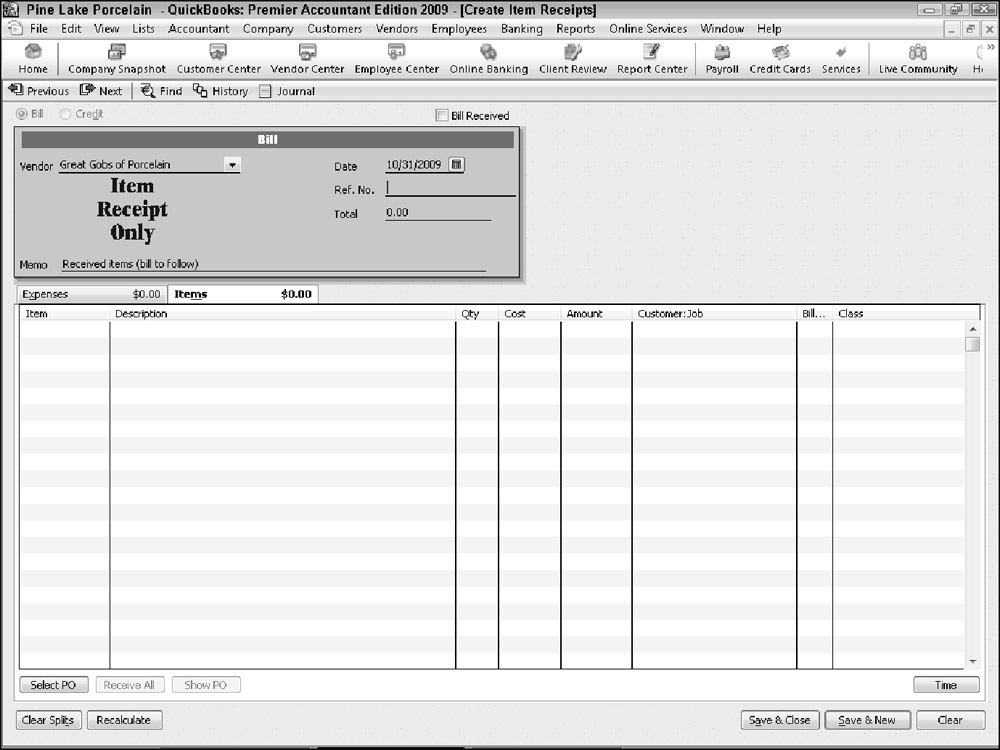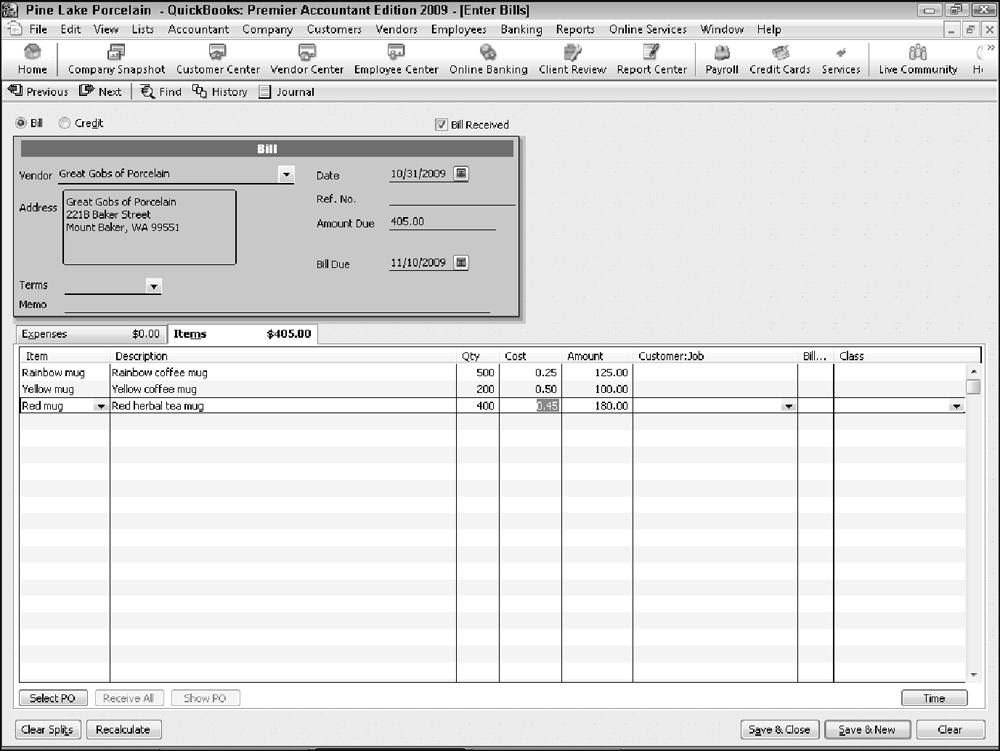When you receive items from a vendor, you can record the receipt. You typically do this when you want to record the receipt of an item even before you receive a bill for the item. For example, in any business with inventory, you want to know exactly how much inventory you have in your warehouse or on your store floor. You don't want to wait to adjust your inventory records for these purchases until you receive the invoice from the vendor. In this scenario, you record when you receive items.
To record item receipts, follow these steps:
-
Choose the Vendors ð Receive Items command.
QuickBooks displays the Create Item Receipts window, as shown in Figure 1.
 Figure 1: The Create Item Receipts window
Figure 1: The Create Item Receipts window 
-
2. Select the vendor from whom you're receiving items from the Vendor drop-down list.
-
Select any P.O.s that you're receiving items on.
If open purchase orders exist for the vendor, QuickBooks displays a Message box. The Message box asks whether you want to receive items against one of the open purchase orders. If the items that you receive are items that you set up on a purchase order, click Yes. When Quick Books displays the Open Purchase Orders dialog box — the dialog box just lists open purchase orders — select the one that ordered the items you are now receiving and then click OK. QuickBooks fills out the Items tab of the Create Item Receipts window by using the information from the purchase order. This automatic data entry of purchase order information should save you time if the items that you're receiving match items on the purchase order.
-
Confirm the receipt date.
Use the Date field to confirm the date of receipt. As with the Date field in other places in QuickBooks, enter the date in mm/dd/yyyy format. Or, you can click the Calendar button that appears to the right of the Date field and choose the date from the pop-up calendar that QuickBooks displays.
-
Use the Total box to identify the total value of the order received, if available.
QuickBooks calculates this total for you by adding up the individual item costs, so you can wait until later.
-
(Optional) Use a reference number.
You can use the Ref. No. field to provide a reference number. For example, you may want to reference the vendor's order number.
-
(Optional) Provide a memo description.
-
Describe the items received.
Use the Items tab to identify the items that you've received. The Items tab of the Create Item Receipts window resembles and works like the Items tab of the Create Purchase Order window. For this reason, I don't discuss how you enter, for example, item codes in the Item column.
-
Describe any related expenses.
The Expenses tab of the Create Item Receipts window works like the Expenses tab of the Write Checks window. If you have questions about how the Expenses tab works.
-
Click either the Save & Close or Save & New button to save the receipt item.
If you click the Save & Close button, QuickBooks saves your item receipt information and closes the Create Item Receipts window. If you click the Save & New button, QuickBooks saves the item receipt information and redisplays a fresh, clean, cleared version of the Create Item Receipts window. You can then use the window to describe the receipts of some other set of items.
That's about all you need to know to work with the Create Item Receipts window. Nevertheless, let me just quickly describe the half-dozen command buttons located at the bottom of the Create Item Receipts window that I haven't referenced in the earlier discussions:
-
Select PO: This command button displays the Open Purchase Orders dialog box. The Open Purchase Orders dialog box lists the purchase orders open for the selected vendor. By selecting a listed purchase order, you tell QuickBooks to fill out the Item tab with the information from that purchase order or orders.
-
Receive All/Clear Qtys: When labeled Receive All, this button says you've received all the items ordered on some purchase order; or when it's labeled Clear Qtys, it clears the received quantities shown in the Items tab if you've specified a purchase order. When you click this button, it changes from Receive All, into Clear Qtys, into Receive All, and so on.
-
Show P.O.: This button shows the selected purchase order.
-
Clear Splits: This button erases any expense or item information that you've entered in the Expenses tab or Items tab. In effect, the Clear Splits button lets you start over in recording the receipt of some item or items.
-
Recalculate: This button recalculates the total amount by using the information that you've entered onto the Expenses tab and the Items tab.
-
Clear: This button clears all the information that you've entered in the Create Item Receipts window, including the Expenses tab information, the Items tab information, and the vendor information shown at the top of the window.
-
Time: This button opens the Select Time Period dialog box, shown in Figure 2, which you use to specify the date range of the work for which you're paying.
 Figure 2: The Select Time Period dialog box
Figure 2: The Select Time Period dialog box






